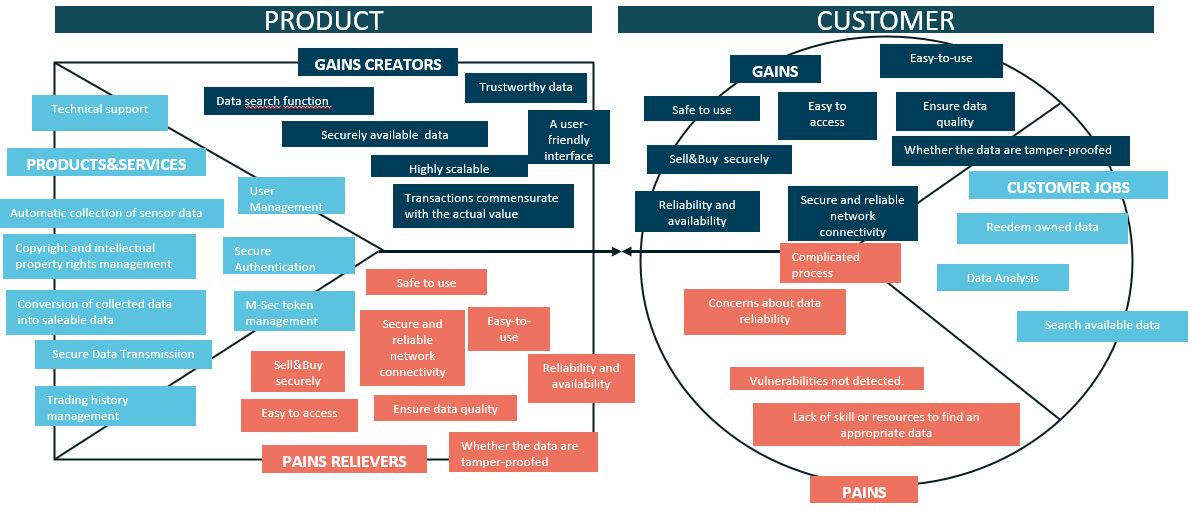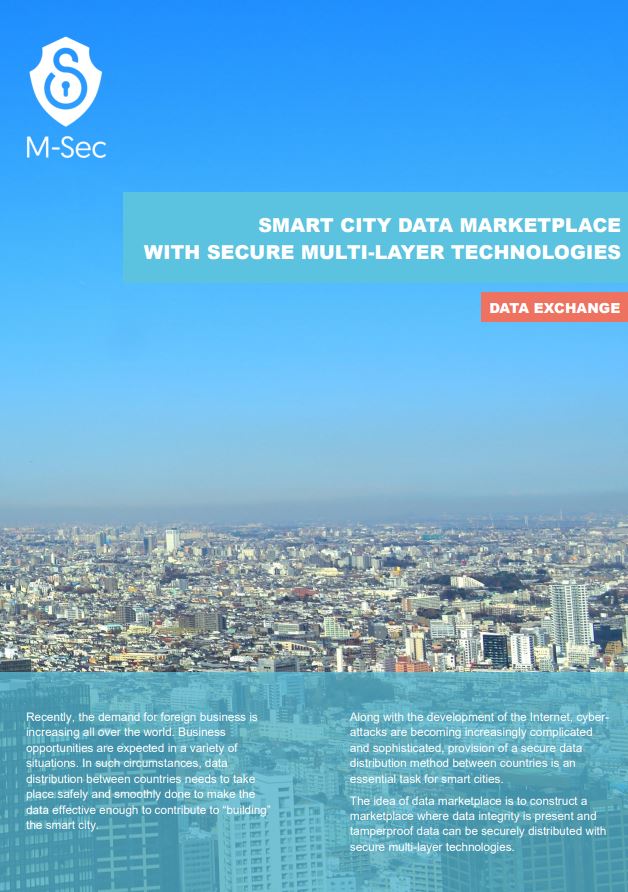Use Case 5 · Smart City Data Marketplace with Secure Multi-Layer Technologies
Overall description
This pilot is a cross border trial, which will be implemented in Santander and Fujisawa. The M-Sec data marketplace is set up for citizens, companies, and municipalities to trade data collected in other use cases and valuable datasets on the internet to distribute data by ensuring Confidentiality, Integrity, Availability, and Privacy of data following GDPR/APPI regulations, so that people or organisations in EU and Japan can utilize the data more effectively.
Recently, the demand for foreign business is increasing all over the world. Business opportunities are expected in a variety of situations. In such circumstances, data distribution between countries needs to take place safely and smoothly to make the data effective enough to contribute to build a smart city. Along with the development of the Internet, cyber-attacks are becoming increasingly complicated and sophisticated, provision of a secure data distribution method between countries is an essential task for smart cities.
The aim of this use case is to construct a marketplace where data integrity is present and tamperproof data can be securely distributed with secure multi-layer technologies.
Challenges it addresses
The initial plan was to recruit participants by coordinating with events in Santander and Fujisawa, by introducing the project at exhibitions, by holding seminars and so on. However, due to the pandemic situation, almost all events such as exhibitions and seminars where people gather have been cancelled or postponed. The project tried to recruit participants through the following methods:
- Presentation of the data marketplace at webinars and asking for participation in the trial
- Presentation of the data marketplace to other pilot participants at the same time
- Asking for participation of stakeholders and related parties
In terms of privacy, no personal data is requested at the registration stage, only an identifier and a password. Moreover, after analysing the data of each pilot to be integrated, it can be assured that no personal data will be transferred to the marketplace. Therefore, there will be no risk related to data store or exchange (off-chain).
Regarding contents, privacy data might be mixed in or uploaded accidentally.
(left click the picture for a better view)
The M-Sec approach
The technical features, mechanisms and interactions of modules that support the use case are based on the M-Sec architecture, shown in the following Architectural view. The core assets utilized for the purposes of the use case is the IoT Marketplace based on Blockchain and the corresponding Middleware.
End users have access to all the services provided by the IoT Marketplace. This way, they are able to register to the platform, upload content, browse and purchase media items etc Additionally, through the integration with other components more assets are indirectly utilized, as will be described in the next sub-sections.
(left click the picture for a better view)
Pilot implementation
Due to a significant delay in the progress of the project in a pandemic situation, the marketplace, which can trade of M-Sec’s use case data or other data, implemented and tried it in the last month of the extended project period. Trials were conducted in Fujisawa and Santander. Since we have validated the trial in Japan and Europe, we think that it is possible to duplicate at least in other cities in Japan and Europe. Mainly, we have implemented a function that allows users of Smile City Report, a participatory sensing app developed in use case 4, to use the app and sell the photos taken there on the marketplace. Smart City Report users can also use it as a starting point to purchase data traded on the marketplace.
(left click the picture for a better view)
Main results and next steps
In this use case, we validated whether different types of users, including citizens, businesses, research institutes, and municipalities, could trade the various data they provide in a secure marketplace. Due to the pandemic situation, a large-scale trial was not possible, but it was conducted by a certain number of users and proved its effectiveness. In the marketplace, transaction security is ensured by blockchain and several other security tools. In addition, the data collected by all other use cases in M-Sec have been integrated so that they can be automatically linked and the data can be traded in the data marketplace. As the research stage of this project, we were able to validate the secure data marketplace, so in the next step, we will continuously explore the possibility of social implementation while spreading and expanding the results of this activity including its business model (see image above).
Lessons Learnt
As discussed at the beginning of the project, UC5 has succeeded in integrating the technology to enable transactions on the secure marketplace in the form of encrypted or anonymized data of other UC1 to UC4. In addition, although it was just before the end of the project period, we were able to validate the marketplace at the user level, albeit on a small scale.
In addition to UC data, we also linked with open data from the city of Santander and open data collected by Secure SOXFire, and implemented of trading various types of data in M-Sec marketplace. The data must be published in an encrypted or anonymized form, but the keyword display, item classification, and menu setting that allow the extracted raw data to be operated without specialized knowledge were some issues that we faced. Although there are still more issues to be solved in order to commercialize the currently implemented marketplace, it was verified that various data can be traded after implementing multi-layered security functions in M-Sec marketplace. Regarding sustainability on future deployment of UC5, please refer to D5.8 for more information.
How can I join?
Contact Keiko Doguchi: a-k_douguchi@east.ntt.co.jp
1
1
Download the Use Case 5 Product Sheet
And watch our latest video on Use Case 5 implementation
- Prev
- Next





